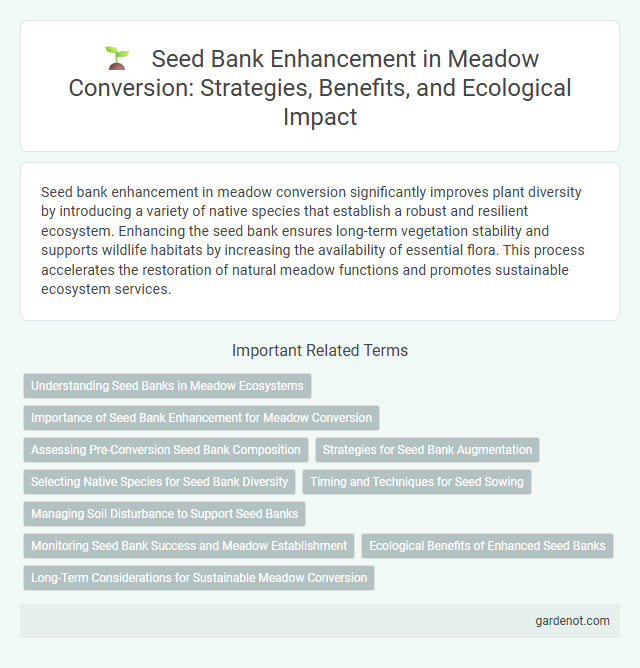Seed bank enhancement in meadow conversion significantly improves plant diversity by introducing a variety of native species that establish a robust and resilient ecosystem. Enhancing the seed bank ensures long-term vegetation stability and supports wildlife habitats by increasing the availability of essential flora. This process accelerates the restoration of natural meadow functions and promotes sustainable ecosystem services.
Understanding Seed Banks in Meadow Ecosystems
Seed banks in meadow ecosystems serve as reservoirs of viable seeds stored in the soil, critical for plant regeneration and biodiversity maintenance. The composition and density of seed banks influence the success of meadow conversion by providing a natural source of species restoration and resilience against environmental fluctuations. Effective management of seed bank enhancement involves assessing seed viability, diversity, and soil conditions to optimize meadow ecosystem recovery and sustainability.
Importance of Seed Bank Enhancement for Meadow Conversion
Enhancing the seed bank is crucial for successful meadow conversion as it ensures a diverse and resilient plant community, promoting long-term ecosystem stability. A robust seed bank provides the native species necessary to outcompete invasive plants, supporting biodiversity and habitat quality. Improving the seed bank through targeted sowing and soil management accelerates meadow restoration and increases overall ecological function.
Assessing Pre-Conversion Seed Bank Composition
Assessing pre-conversion seed bank composition involves analyzing soil samples to identify native and invasive seed species present before meadow restoration begins. This evaluation helps determine seed viability, density, and diversity, guiding effective management practices to promote desirable plant communities. Understanding seed bank composition is crucial for predicting restoration outcomes and optimizing seed addition strategies.
Strategies for Seed Bank Augmentation
Strategies for seed bank augmentation in meadow conversion emphasize the introduction of diverse native species to increase genetic variability and ecosystem resilience. Techniques such as direct seeding, soil transfer from donor sites, and the incorporation of seed coatings with growth stimulants enhance seed viability and establishment rates. Maintaining optimal soil conditions and monitoring seedling emergence are critical for successful seed bank enhancement and long-term meadow restoration.
Selecting Native Species for Seed Bank Diversity
Selecting native species for seed bank diversity reinforces ecosystem resilience by prioritizing locally adapted plants with high genetic variability. This approach ensures the preservation of native flora, supports pollinator networks, and improves restoration success by maintaining habitat-specific ecological functions. Incorporating region-specific seed collections increases the germination rates and long-term sustainability of meadow conversions.
Timing and Techniques for Seed Sowing
Optimal timing for seed sowing in meadow conversion is during early autumn or spring when soil temperatures range between 10-15degC, promoting maximum germination rates. Techniques such as surface broadcasting followed by light raking improve seed-to-soil contact, enhancing establishment success. Incorporating a seed mix of native grasses and wildflowers with varied germination periods ensures prolonged meadow biodiversity and resilience.
Managing Soil Disturbance to Support Seed Banks
Managing soil disturbance is crucial for enhancing seed bank viability in meadow conversion projects, as minimal disruption preserves the stratification and diversity of native seeds. Techniques such as careful tilling depth control and targeted disturbance zones help maintain soil microbial communities that support seed germination and nutrient cycling. Prioritizing soil structure integrity promotes the natural regeneration of native grasses and wildflowers, ensuring long-term meadow resilience.
Monitoring Seed Bank Success and Meadow Establishment
Monitoring seed bank success involves regular sampling and germination testing to evaluate seed viability and species diversity within the soil. Enhanced seed bank assessment techniques, such as molecular markers and seedling emergence assays, provide accurate data on seed density and composition crucial for meadow establishment. Effective monitoring informs adaptive management strategies, ensuring optimal conditions for native meadow species to thrive and achieve sustainable restoration outcomes.
Ecological Benefits of Enhanced Seed Banks
Enhanced seed banks significantly improve meadow restoration by increasing genetic diversity and species resilience, which supports ecosystem stability and adaptive capacity. They provide a critical reservoir of native plant species, promoting habitat complexity and fostering pollinator populations essential for ecosystem functions. Improved seed bank quality accelerates vegetation recovery following disturbances, contributing to long-term carbon sequestration and soil health enhancement.
Long-Term Considerations for Sustainable Meadow Conversion
Enhancing seed banks through the use of diverse, locally sourced native species supports long-term ecological resilience in meadow conversion projects. Incorporating a mix of perennial grasses and wildflowers ensures sustained biodiversity and soil health over time. Monitoring seed viability and adaptive species compositions can maintain ecosystem stability amid changing environmental conditions.
Seed bank enhancement Infographic

 gardenot.com
gardenot.com